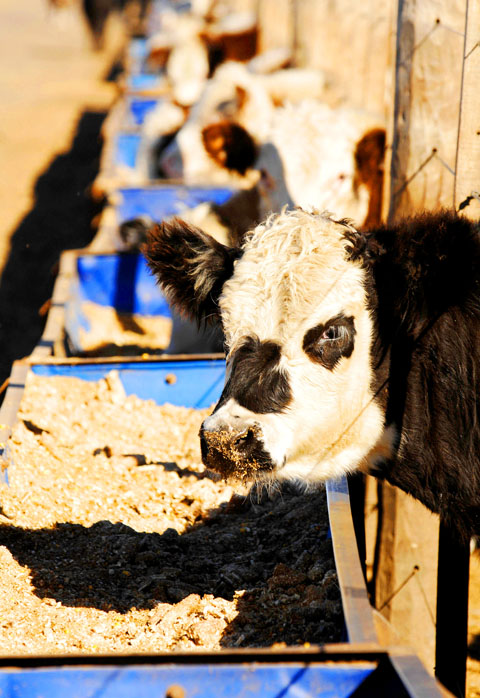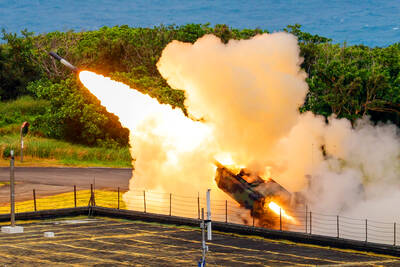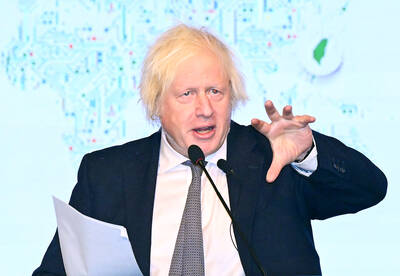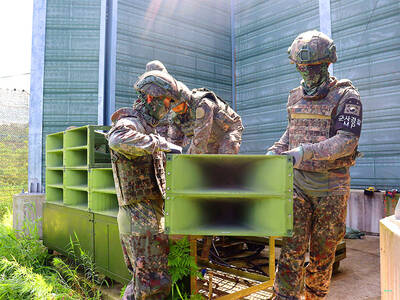For 100 years, cattle breeders refined their beef on the vast Argentine grasslands.
With the help of mild winters, regular rainfall and fertile soil, ranchers grazed top-notch British breeds like Hereford and Angus on rich grasses, producing meat with a texture and taste craved throughout the world.
“Argentina is to beef what Cuba is to cigars,” says Juan Pablo Thieriot, co-founder of Estancia Beef, which exports Argentine and Uruguayan grass-fed meat.

PHOTO: AP
But soaring world food prices may spell the end of the great Argentine steak.
Demand for grain and soy is pushing Argentine ranchers to till their pastures in crops. Cattle that once roamed the pampas are increasingly fattened on corn in cramped feedlots instead. Top beef producers are being pushed toward a system that has been criticized in the US for putting cattle in unnatural environments and creating meat with a mass-produced taste.
About 30 percent of Argentine cattle now finish their lives in feedlots, the Argentine Feedlot Chamber said. Ten or fifteen years ago, that number was zero.
“Ranching here is going from an artisan craft, based on grass, to a more industrial system, similar to the United States,” said Eduardo Pereda, whose family founded the Nueva Castilla ranch in Trenque Lauquen in 1883.
Nueva Castilla now devotes vast tracts of land to corn and sunflowers, while thousands of cattle are crowded into mud-floored corrals lined with plastic feeding troughs.
Three years ago, about half the ranch’s arable land was devoted to pasture. Today, that number is below 9 percent. This year will be the first that some of Nueva Castilla’s animals never see pasture.
Feedlot cattle are now two-and-a-half to three times more profitable than those raised on pasture when combined with crop production.
“One hectare in crops brings in US$500 per year,” said Pablo Tassone, who oversees the Nueva Castilla herd of 24,000 head. “A hectare in pastured beef, if you’re really good, won’t bring in more than US$200.”
Tassone said feedlot beef does tend to be fattier than grass-fed meat. But by feeding his cattle primarily corn husks, he says, he can produce beef that is practically the same quality while meeting the pressures of an international market.
“We’re giving them food much like what they eat in pasture,” he said. “But they grow faster this way.”
Other major beef exporters such as Brazil and Australia are joining the trend, which is also fueled by rising beef consumption worldwide as middle-class incomes and tastes take hold in developing countries. Corn-fed cows in lots where they can’t roam fatten quicker. In the last 10 years, Australia has seen about a 50 percent hike in the number of cattle on feed instead of grass, while Brazil has seen a threefold increase.
The change so far will have little impact in the US, which bans imports of raw Argentine beef because of concerns about foot-and-mouth disease. Argentina says it has eradicated the disease and that the ban has more to do with politics than health.
The country’s best steaks are sent to Europe under the EU’s Hilton Quota, which regulates the import of top quality beef — always grass-fed — from a number of places. Argentine steaks fetch the highest prices under the quota and make up the majority of beef imports, Thieriot said.
Argentina’s switch to crops started about a decade ago with the introduction of new technology, including genetically modified crops and no-till farming, a technique that prevents erosion and improves moisture retention in soil. The trend accelerated as international prices for grain and other commodities began to rise in 2002 and have soared in the last two years.
When the Argentine government implemented price controls and export bans to keep domestic beef prices low, even more ranchers switched to farming. The government began subsidizing feedlots to ensure a steady supply of beef to Argentines, who lead the world in beef consumption at an average of 65kg a year.
US agribusiness sees opportunities in Argentina’s switch from ranching to farming. Last year, Tyson Foods said it planned to expand feedlot capacity in central Argentina, investing in a 25,000-head lot jointly run by Cresud, an Argentine agribusiness, and Cactus Feeders, a Texas-based operator.
In the US, feedlots have been criticized for their use of growth hormones and antibiotics. But in Argentina, hormones are banned by the government, and antibiotic use is at a minimum.
Some longtime fans say they can tell the difference. Malcolm Harris began importing Argentine beef to the UK under the label Pampas Plains five years ago because he missed the meat after living in Argentina for five years.
“It was like an itch I couldn’t scratch,” he said.
He said he was disappointed on his most recent trip to Argentina.
“Years ago, I never had a bad steak in Argentina,” Harris said. “This year was the first.”
Also See: Eat less meat to save the world

Authorities have detained three former Taiwan Semiconductor Manufacturing Co (TMSC, 台積電) employees on suspicion of compromising classified technology used in making 2-nanometer chips, the Taiwan High Prosecutors’ Office said yesterday. Prosecutors are holding a former TSMC engineer surnamed Chen (陳) and two recently sacked TSMC engineers, including one person surnamed Wu (吳) in detention with restricted communication, following an investigation launched on July 25, a statement said. The announcement came a day after Nikkei Asia reported on the technology theft in an exclusive story, saying TSMC had fired two workers for contravening data rules on advanced chipmaking technology. Two-nanometer wafers are the most

DEFENSE: The first set of three NASAMS that were previously purchased is expected to be delivered by the end of this year and deployed near the capital, sources said Taiwan plans to procure 28 more sets of M-142 High Mobility Artillery Rocket Systems (HIMARS), as well as nine additional sets of National Advanced Surface-to-Air Missile Systems (NASAMS), military sources said yesterday. Taiwan had previously purchased 29 HIMARS launchers from the US and received the first 11 last year. Once the planned purchases are completed and delivered, Taiwan would have 57 sets of HIMARS. The army has also increased the number of MGM-140 Army Tactical Missile Systems (ATACMS) purchased from 64 to 84, the sources added. Each HIMARS launch pod can carry six Guided Multiple Launch Rocket Systems, capable of

CHINA’s BULLYING: The former British prime minister said that he believes ‘Taiwan can and will’ protect its freedom and democracy, as its people are lovers of liberty Former British prime minister Boris Johnson yesterday said Western nations should have the courage to stand with and deepen their economic partnerships with Taiwan in the face of China’s intensified pressure. He made the remarks at the ninth Ketagalan Forum: 2025 Indo-Pacific Security Dialogue hosted by the Ministry of Foreign Affairs and the Prospect Foundation in Taipei. Johnson, who is visiting Taiwan for the first time, said he had seen Taiwan’s coastline on a screen on his indoor bicycle, but wanted to learn more about the nation, including its artificial intelligence (AI) development, the key technology of the 21st century. Calling himself an

South Korea yesterday said that it was removing loudspeakers used to blare K-pop and news reports to North Korea, as the new administration in Seoul tries to ease tensions with its bellicose neighbor. The nations, still technically at war, had already halted propaganda broadcasts along the demilitarized zone, Seoul’s military said in June after the election of South Korean President Lee Jae-myung. It said in June that Pyongyang stopped transmitting bizarre, unsettling noises along the border that had become a major nuisance for South Korean residents, a day after South Korea’s loudspeakers fell silent. “Starting today, the military has begun removing the loudspeakers,”